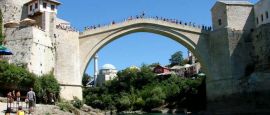Getting around Bosnia and Herzegovina
Driving in Bosnia and Herzegovina can be a rewarding experience, offering stunning views of its mountainous landscapes, historic towns, and unspoiled nature. However, beware that rural and mountain roads can be narrow, winding, and less well-maintained.
Visitors should exercise caution when travelling outside of main cities and towns. Unpaved roads should be avoidable. The risk of landmines has decreased in the last few years, and most mines remaining from the Bosnian War are now clearly marked with warning signs, often red triangles with the words "Pazi Mine" ("Beware of Mines").
The capital, Sarajevo, serves as the central hub for Bosnia and Herzegovina's main transport routes. Key routes include:
• Westward to Banja Luka and onwards to Zagreb, Croatia
• Northward to Doboj and then to Osijek, Croatia
• Eastward to Zvornik and Belgrade, Serbia
• Southward to Mostar and the Adriatic coast
• Southeastward to Foča and Podgorica, Montenegro
Metered taxis are plentiful in larger cities and tourist areas. Ride-hailing services like MojTaxi and Bolt are also available. Tipping is not mandatory, but rounding up the fare is common and appreciated.
Speed limits are typically 50 km/h (31 mph) in urban areas, 80 km/h (50 mph) on main roads, and 130 km/h (81 mph) on highways.
Seat belts are mandatory, and headlights are required during the day.
Winter tyres are required between 15 November and 15 April.
Foreign drivers should have an International Driving Permit, Green Card Insurance, and Vehicle Registration Documents.
Domestic rail travel in Bosnia and Herzegovina offers a scenic and affordable way to explore the country, though it is somewhat limited in coverage and frequency. The key routes are Sarajevo to Mostar, Sarajevo to Banja Luka, and Sarajevo to Doboj. Always check schedules in advance as they can change seasonally or due to infrastructure maintenance.
Do you have any Feedback about this page?
© 2025 Columbus Travel Media Ltd. All rights reserved. No part of this site may be reproduced without our written permission, click here for information on Columbus Content Solutions.




 You know where
You know where